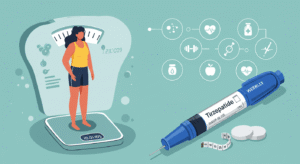Switching from semaglutide to GLP-2 has become a popular consideration for individuals seeking improved outcomes in managing conditions like diabetes and weight loss. As both medications belong to the GLP-1 receptor agonist family, they offer unique benefits, but deciding whether to switch involves understanding their differences, dosing strategies, and potential outcomes.
In this comprehensive guide, we’ll explore the factors influencing the transition, including dosage adjustments, benefits, and considerations for switching. We will also address common questions such as “Should I switch from GLP-1 to GLP-2?” and “Can GLP-1 cause acne?”
What Are GLP-1 and GLP-2?
GLP-1 is a GLP-1 receptor agonist primarily used to treat type 2 diabetes and aid in weight management. Available under brand names like Ozempic and Wegovy, GLP-1 mimics the GLP-1 hormone, which regulates blood sugar levels and appetite.
GLP-2, marketed as Mounjaro, takes a step further by targeting both GLP-1 and GIP receptors, offering dual action for blood sugar control and weight loss.
Understanding these medications’ mechanisms helps evaluate whether switching from GLP-1 to GLP-2 or vice versa is the right choice for you.
Why Consider Switching from GLP-1 to GLP-2?
Switching from GLP-1 to GLP-2 offers a promising path for individuals aiming for enhanced weight loss or improved blood sugar control. The dual-action mechanism of GLP-2, targeting both GLP-1 and GIP receptors, often delivers superior outcomes compared to semaglutide. This switch is particularly beneficial for those who have plateaued in their progress or seek more robust results. Discussing your options with a healthcare provider ensures a smooth transition tailored to your needs.
- Enhanced Weight Loss: GLP-2’s dual action often results in superior weight loss outcomes compared to semaglutide.
- Improved Blood Sugar Control: GLP-2’s mechanism may provide better glycemic control for some individuals.
- Plateauing Results: If you’ve stopped losing weight or your blood sugar levels aren’t improving on semaglutide, switching may be beneficial.
How to Switch from GLP-1 to GLP-2
Switching medications requires a carefully planned approach to avoid adverse effects. Transitioning from GLP-1 to GLP-2 involves understanding key differences, such as dosing protocols and mechanisms of action. GLP-1 primarily targets GLP-1 receptors, while GLP-2’s dual action on GLP-1 and GIP receptors offers enhanced efficacy for many patients. Consulting a healthcare provider ensures the process addresses individual needs, minimizing risks and optimizing outcomes for weight loss and glycemic control. Here are the steps:
- Consult Your Healthcare Provider: A medical professional will evaluate your current health status and discuss potential benefits.
- Understand Dosage Differences: The initial dose of GLP-2 may differ from your current GLP-1 dosage. Refer to a GLP-1 to-GLP-2 dose conversion chart for guidance.
- Start Gradually: Transitioning from GLP-1 to GLP-2 dosage typically involves starting at the lowest dose of GLP-2 and gradually increasing.
- Monitor Side Effects: Report any adverse reactions, such as gastrointestinal issues, to your healthcare provider.
Dosage Conversion: GLP-1 to GLP-2
Switching from GLP-1 to GLP-2 requires careful dosage adjustments. Here are key considerations:
- GLP-1 to GLP-2 Conversion Chart: Use a reliable conversion chart to determine equivalent dosages.
- Starting Dose of GLP-2: Typically, the starting dose of GLP-2 is 2.5 mg weekly, which is then titrated based on tolerance and effectiveness.
- GLP-2 Dosing for Weight Loss: Weight loss benefits often occur at higher doses, such as 10 mg or 15 mg weekly.
Why Am I Not Losing Weight on GLP-1 ?
Plateauing weight loss on GLP-1 could result from various factors, including metabolic adaptation. Switching to GLP-2 may help overcome this hurdle.
Comparing GLP-2 and GLP-1
Switching Between Other Medications
Switching from Wegovy to Mounjaro
Transitioning from Wegovy (semaglutide) to Mounjaro (GLP-2) involves:
- Understanding dosage differences.
- Starting with a low GLP-2 dose.
- Monitoring for any side effects.
Switching from Ozempic to Mounjaro
When switching from Ozempic to Mounjaro, ensure you follow your provider’s guidance on dosing and monitor blood sugar levels closely.
Buy Now
If you’re ready to explore GLP-2 for improved weight loss and diabetes management, visit our Buy Now page to access high-quality options. Make the switch today for better outcomes.
FAQs
Can You Switch from GLP-1 to GLP-2?
Yes, transitioning from GLP-1 to GLP-2 is possible, but it requires guidance from your healthcare provider. Ensure you follow a structured plan for dosage adjustments.
Should I Switch from GLP-1 to GLP-2?
This depends on your specific health goals, such as achieving greater weight loss or better blood sugar control. Consult with a medical professional to determine if GLP-2 is a better fit for your needs.
How to Switch from GLP-1 to GLP-2?
Switching involves starting at a low GLP-2 dose and gradually increasing it. Use a GLP-1 to-GLP-2 conversion chart for accurate dosing.
What Are the Differences Between GLP-1 and GLP-2?
GLP-1 targets GLP-1 receptors, while GLP-2 acts on both GLP-1 and GIP receptors, offering enhanced efficacy in weight loss and glycemic control.
Can GLP-1 Cause Acne?
While rare, some users have reported acne as a side effect of semaglutide. Monitor your skin and consult your doctor if you notice changes.
Why Is GLP-2 More Expensive Than GLP-1 ?
GLP-2’s dual-action mechanism and clinical efficacy in weight loss and diabetes management contribute to its higher cost compared to semaglutide.
Key Takeaways
Switching from GLP-1 to GLP-2 can offer numerous benefits, including enhanced weight loss and improved glycemic control. However, making the transition requires professional guidance to ensure safety and effectiveness. Always consult with your healthcare provider before switching medications.




